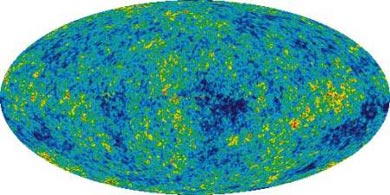How to 3D-print your own baby universe
November 1, 2016

Cosmic microwave background radiation — 2D view (credit: NASA)
Researchers have created a 3D-printed cosmic microwave background (CMB) — a map of the oldest light in the universe — and have provided the files for download.
The cosmic microwave background (CMB) is the “glow” that the universe had in the microwave range. It maps the oldest light in the universe and tells astronomers more about the early universe and the formation of structures within it, such as galaxies. It was imprinted when the universe was only 380,000 years old — when the universe first became transparent, instead of an opaque fog of plasma and radiation.
The Planck satellite is making increasingly more detailed maps of the CMB, which are increasingly difficult to view and explore. To address this issue, Dave Clements, PhD, from the Department of Physics at Imperial College London and team have created plans for 3D printing the CMB. The work is published (open access) in the European Journal of Physics.

3D-printed CMB model. The bumps (not to scale) and associated colors represent both higher temperatures and higher densities of matter (credit: D. L. Clements et al./European Journal of Physics)
The 3D-printed model represents differences in the temperature as bumps and dips on a spherical surface and also as colors (from blue for coldest to red as warmest, corresponding to colors in the flat view). These temperature differences relate to different densities of matter, which correspond to the formation of structures in the universe, including stars, galaxies, galaxy clusters, and superclusters.
The CMB can be printed from a range of 3D printers, and two file types have been created by the team: one for simple single-color structures and one that includes the temperature differences represented as colors as well as bumps and dips. The files are free to download.
Dave Clements’ latest book, Infrared Astronomy — Seeing the Heat: from William Herschel to the Herschel Space Observatory, is available now.
Abstract of Cosmic sculpture: a new way to visualise the cosmic microwave background
3D printing presents an attractive alternative to visual representation of physical datasets such as astronomical images that can be used for research, outreach or teaching purposes, and is especially relevant to people with a visual disability. We here report the use of 3D printing technology to produce a representation of the all-sky cosmic microwave background (CMB) intensity anisotropy maps produced by the Planck mission. The success of this work in representing key features of the CMB is discussed as is the potential of this approach for representing other astrophysical data sets. 3D printing such datasets represents a highly complementary approach to the usual 2D projections used in teaching and outreach work, and can also form the basis of undergraduate projects. The CAD files used to produce the models discussed in this paper are made available.
